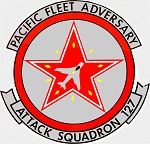Hobby Master HA3353 US Navy Northrop F-5E Tiger II Fighter - VFA-127 Desert Bogeys, Fallon Naval Air Station, Nevada [Aggressor Scheme] (1:72 Scale)
"Obsolete weapons do not deter."
- British Prime Minister Margaret Thatcher
 The Northrop F-5A/B Freedom Fighter and F-5E/F Tiger II are part of a family of widely used light supersonic fighter aircraft, designed and built by Northrop in the United States, beginning in the 1960s. Hundreds remain in service in air forces around the world in the early 21st Century, and the type has also been the basis for a number of other aircraft.
The Northrop F-5A/B Freedom Fighter and F-5E/F Tiger II are part of a family of widely used light supersonic fighter aircraft, designed and built by Northrop in the United States, beginning in the 1960s. Hundreds remain in service in air forces around the world in the early 21st Century, and the type has also been the basis for a number of other aircraft.
The F-5 started life as a privately funded light fighter program by Northrop in the 1950s. The first generation F-5A Freedom Fighter entered service in the 1960s. Over 800 were produced through 1972 for U.S. allies during the Cold War. The USAF had no need for a light fighter, but it did specify a requirement for a supersonic trainer and procured about 1,200 of a derivative airframe for this purpose, the T-38 Talon.
The improved second-generation F-5E Tiger II was also primarily used by American Cold War allies and, in limited quantities, served in US military aviation as a training and aggressor aircraft; Tiger II production amounted to 1,400 of all versions, with production ending in 1987. Many F-5s continuing in service into the 1990s and 2000s have undergone a wide variety of upgrade programs to keep pace with the changing combat environment. The F-5 was also developed into a dedicated reconnaissance version, the RF-5 Tigereye.
The F-5 serves as a starting point for a series of design studies which resulted in the twin-tailed Northrop YF-17 and the F/A-18 series of carrier-based fighters. The F-20 Tigershark was an advanced version of the F-5E that did not find a market. The F-5N/F variants remain in service with the United States Navy and United States Marine Corps as an adversary trainer
Pictured here is a 1:72 scale rendition of a US Navy Northrop F-5E Tiger II fighter that was attached to VFA-127 "Desert Bogeys," then deployed to Fallon Naval Air Station, Nevada.
Sold Out!
Dimensions:
Wingspan: 7-3/4-inches
Length: 4-1/2-inches
Release Date: November 2014
 Historical Account: "Desert Bogeys" - VFA-127, nicknamed the Royal Blues from the 1960s to 1980, and the Cyclons from 1981 onward, was a Strike Fighter Squadron of the U.S. Navy. Established as an Attack Squadron designated VA-127 on 15 June 1962 at NAS Lemoore, California, it was redesignated VFA-127 on March 1st, 1987. On October 1st of that year, it moved to NAS Fallon, Nevada. The squadron was disestablished on March 23rd, 1996.
Historical Account: "Desert Bogeys" - VFA-127, nicknamed the Royal Blues from the 1960s to 1980, and the Cyclons from 1981 onward, was a Strike Fighter Squadron of the U.S. Navy. Established as an Attack Squadron designated VA-127 on 15 June 1962 at NAS Lemoore, California, it was redesignated VFA-127 on March 1st, 1987. On October 1st of that year, it moved to NAS Fallon, Nevada. The squadron was disestablished on March 23rd, 1996.
In 1975, the squadron's primary mission changed. Fleet Replacement Pilot training and the Fleet Replacement Aviation Maintenance Program were discontinued. The squadron's new missions included basic refresher all weather jet instrument training, air combat maneuvering adversary training, foreign pilot training, and jet transition/refresher training. In November 1975, CNO officially tasked VA-127 with the mission of air combat maneuvering (ACM) adversary training. On October 1st, 1983, The squadron's instrument training mission was dropped and the primary mission became the Adversary Role (Dissimilar Air Combat Maneuvering).





![USAAC North American B-25B Mitchell Medium Bomber - Lt. Richard E. "Dick" Cole, 17th Bombardment Group "Doolittle's Raiders", USS Hornet (CV-8), April 18th, 1942 [Signature Edition] (1:72 Scale)](http://cdn4.volusion.store/qh9e9-jdqv9/v/vspfiles/photos/AF10111S-1.jpg?v-cache=1740197136)



